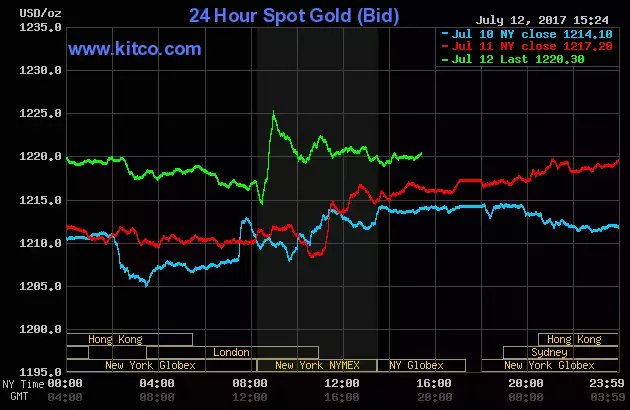Fed Watchers Left Guessing After Yellen House of Reps Testimony
News
|
Posted 13/07/2017
|
6097
Guessing, it would seem, is not an inappropriate term to describe a situation where both gold and stocks rally simultaneously. That is precisely what we saw overnight after Federal Reserve chair Janet Yellen presented her now dovish remarks in prepared testimony to the US House of Representatives.

The gold price bounce was modest and possibly partly attributable to bargain-hunters and short-covering, but it was noticeable nonetheless. The reaction in equities however was much more conclusive.
About 5 hours ago, Gregory Mannarino of traderschoice.net remarked that “the markets are in full-blown rally mode”. With the DJIA up in the vicinity of 130 points at the time, Gregory stated that US equities will probably see “new records in the next several days”.
So what’s driving this and what can we learn from it? Two important takeaway points from Yellen’s comments were as follows. Firstly, Yellen said that interest rates do not need to move much higher and secondly, the Fed is almost at a neutral point.
Equities loved this new story of course as it means the Federal Reserve (at least until the next “180”) is going to keep doing what they’ve been doing; suppressing interest rates and punishing savers.
In the last weeks and months, Yellen had been sounding Hawkish, speaking of raising rates and shrinking their balance sheet; something we wrote about exactly one week ago today when discussing the release of the June FOMC minutes. With this most recent release, any shrinking of the balance sheet will likely be so gradual that it will probably be inconsequential.
In a concerted guidance effort, Lael Brainard also came out yesterday sounding somewhat dovish and some are suggesting that the Fed may be reacting to concern about action in the bond market; namely how bonds were selling off and interest rates were consequently rising.
Again we circle back to what the prudent investor can learn from this latest Federal Reserve sparked rally. Almost unarguable is the conclusion that these price actions are the result of the comments of a single individual and not the result of fundamental free-market operation. As such, they are without fundamental foundation and are hence firmly in the speculative rather than fundamental basket. Chasing gains here should be done with the knowledge that the profits can disappear as quickly as they appeared.
Almost unarguable too is the fact that the difficulties faced by savers in this new normal of suppressed returns is likely to remain. Given that cash allocations are typically the defence against deflationary warning signs such as those we discussed yesterday, this puts individuals in a catch-22.
By storing cash savings in real money and denominating these in ounces rather than dollars, a prudent investor stands a chance of balancing the conflicting need to be invested (so as to avoid the war on savings and currency risk) and to be cash rich (to mitigate deflation risks).